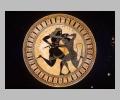| Collection: | Toledo Museum of Art |
| Summary: | Tondo: Theseus and the Minotaur. Exterior, sides A and B: inscriptions by potter. |
| Ware: | Attic Black Figure |
| Painter: | Attributed to the Tleson Painter |
| Potter: | Signed by Tleson |
| Date: | ca. 550 BC |
| Dimensions: | H. 0.155 m., d. rim 0.24 m., w. with handles 0.32 m., d. foot 0.095 m. |
| Primary Citation: | |
| Shape: | Lip cup |
| Beazley Number: | 350734 |
| Period: | Archaic |
Condition:
The tondo includes modern restoration of Theseus's waist to mid-left thigh, part of his sword and part of the Minotaur's right arm.
Decoration Description:
Tondo: Theseus and the Minotaur. On the left, Theseus wields his sword in preparation for stabbing the Minotaur in the throat. He pushes the Minotaur's head down by holding onto its horn with his left hand. Theseus is wearing chitoniskos, fillet and nebris tied in front, and a scabbard hangs at his side. The Minotaur, starting to fall to its left knee, grabs Theseus's sword arm with its right arm and his left with its left. The Minotaur's skin appears almost scaly, with short incised marks covering it except for its neck, nose, feet and tail. There is much symmetry between the two figures, but Theseus's erect stance and aggressive posture show him to be the victor in the struggle.
Added white is used for the hilt of Theseus's sword, the end of his scabbard, the markings on his nebris, and rows of dots on the collar and sleeves of his chiton. The border of the tondo is a band of alternating red and black tongues encircled by four narrow concentric bands on the inside and three on the outside.
Exterior, sides A and B: On each side the inscriptions are bounded on left and right by palmettes attached to the handles by long scroll-like tendrils. The cores of the palmettes have added red. A narrow reserved band runs around the edge of the lip, and a second one encircles the lower part of the bowl.
Inscriptions:
In the field of the interior are inscribed the words
Sources Used:
Other Bibliography:





